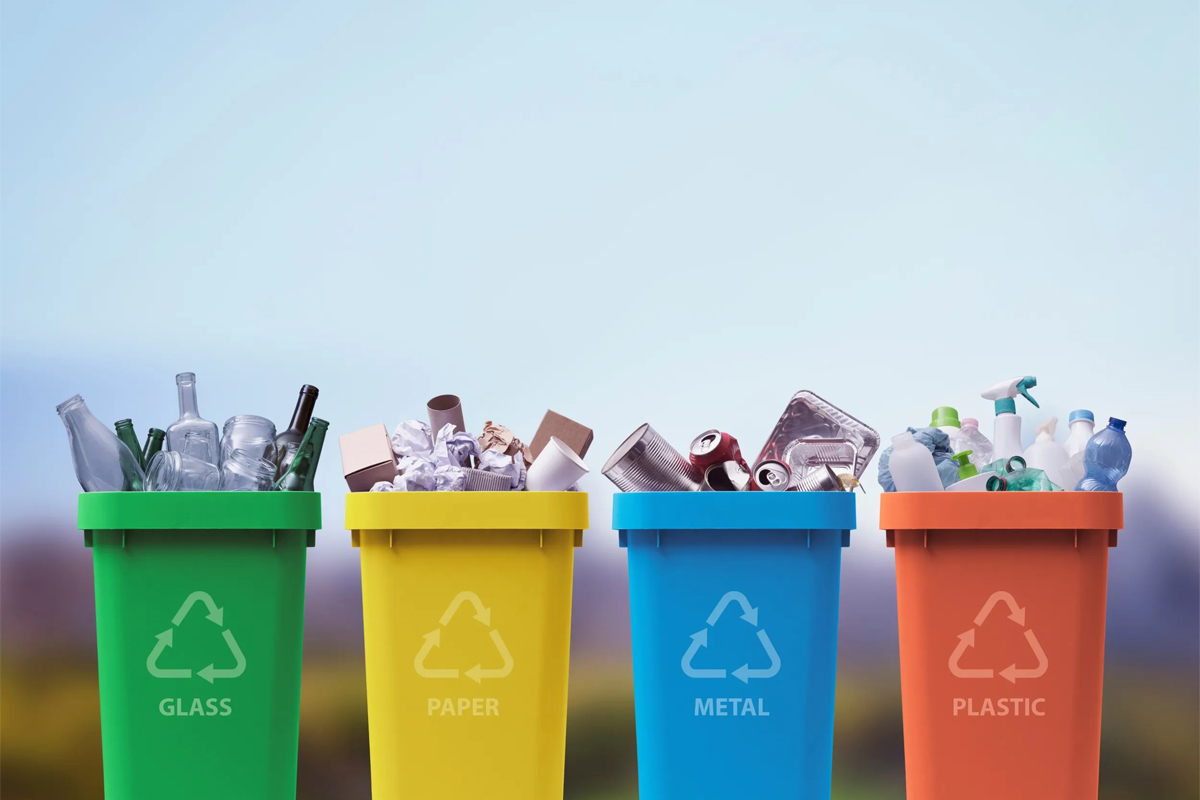Solid Waste At A Glance


What is Solid Waste?
Solid waste refers to any discarded material that is not in liquid or gas form. It encompasses a wide range of materials that are no longer needed, useful, or wanted, and are thus thrown away. These materials can come from various sources including households, businesses, industries, agriculture, and public services.


Types of Solid Waste:
Municipal Solid Waste (MSW):
- Household Waste: Includes everyday items such as packaging, food scraps, yard waste, furniture, clothing, bottles, and appliances.
- Commercial Waste: Generated by businesses such as offices, retail stores, restaurants, and hotels. Examples include packaging, food waste, paper, and plastics.
- Industrial Waste:
- Non-Hazardous Industrial Waste: Produced by manufacturing and industrial processes. Examples include scrap metal, plastics, wood, and other process by-products.
- Hazardous Industrial Waste: Contains dangerous substances that require special handling and disposal. Examples include chemicals, solvents, and heavy metals.
- Agricultural Waste: Includes waste generated from farming activities such as crop residues, manure, and pesticides containers.
- Construction and Demolition Waste: Waste from construction, renovation, and demolition activities. Examples include concrete, wood, metals, bricks, glass, and building materials.
- Biomedical Waste: Generated from healthcare facilities such as hospitals, clinics, and laboratories. Examples include needles, syringes, bandages, and pharmaceuticals.
- Electronic Waste (E-Waste): Discarded electronic devices and components such as computers, televisions, cell phones, and batteries.


Characteristics of Solid Waste:
- Biodegradable: Organic waste that can decompose naturally, such as food scraps, paper, and yard waste.
- Non-Biodegradable: Materials that do not break down easily, such as plastics, metals, and glass.
- Hazardous: Waste that poses substantial or potential threats to public health or the environment, requiring special disposal methods.
- Non-Hazardous: Waste that does not pose a direct threat to health or the environment under normal conditions.

Solid Waste Management:
Effective management of solid waste is crucial for environmental sustainability and public health.
By managing solid waste effectively, we can minimize its negative impacts on the environment and human health, and create a more sustainable and efficient use of resources.
Key steps in solid waste management include:
- Collection:
- Gathering solid waste from residential, commercial, and industrial sources.
- Gathering solid waste from residential, commercial, and industrial sources.
- Transportation:
- Moving collected waste to processing or disposal facilities.
- Moving collected waste to processing or disposal facilities.
- Processing and Recovery:
- Recycling: Converting waste materials into new products.
- Composting: Decomposing organic waste to produce compost for use in agriculture and landscaping.
- Disposal:
- Landfills: Burying waste in designated sites, designed to minimize environmental impact.
- Waste-to-Energy Facilities: Converting non-recyclable waste materials into usable heat, electricity, or fuel through various processes.

Commercial Solid Waste Generators (WG) in Jordan

Commercial Solid Waste Generators (WG) in Jordan refer to all non-residential entities, including:
- Commercial sector.
- Private businesses.
- Industrial/Manufacturing plants.
- Public institutions (government building, public schools/universities, foreign embassies, public hospitals).
- Civil society.
- Urban/peri-urban farms.
- Medical waste produced by hospitals, pharmacies, and medical offices.

Situation in Amman

Every day, the Al Ghabawi landfill receives 3,200 tons of Amman’s waste, with at least 40 percent
generated by the commercial sector according to Greater Amman Municipality (GAM) estimates.
While Amman’s waste generation continues to climb by more than 5 percent per year, optimistic
estimates peg Amman’s recycling rate at a paltry 7 percent, well below other cities in the region.
Waste generators continue to choose landfilling, and manufacturers continue to choose virgin materials due to their low cost and convenience compared to current recycling offerings.

How long does it take to degrade?

The time it takes for various materials to degrade can vary greatly depending on environmental conditions such as temperature, moisture, and the presence of microorganisms. Understanding the degradation times of various materials highlights the importance of recycling and proper waste management.
Materials that take hundreds or thousands of years to decompose can cause long-term environmental damage, making it crucial to reduce, reuse, and recycle wherever possible.

The 3R's Concept

The concept of the 3R’s is a foundational principle in waste management and environmental conservation, aimed at minimizing waste and promoting sustainable practices. The 3R’s—Reduce, Reuse, Recycle—are essential practices for managing waste and promoting environmental sustainability.
By integrating these principles into daily life, individuals and communities can significantly reduce their environmental impact, conserve resources, and contribute to a healthier planet.

Why Recycling is Important?
Recycling plays a crucial role in preserving our environment, conserving resources, and supporting sustainable development.
Here are key reasons why recycling is essential:
- Environmental Protection:
- Reduces Pollution:
Recycling helps decrease air and water pollution by minimizing the need for traditional waste disposal methods like incineration and landfilling. - Conserves Landfill Space:
By diverting waste from landfills, recycling reduces the amount of space required for waste disposal and prevents the creation of new landfills, which can cause environmental degradation.
- Reduces Pollution:
- Resource Conservation:
- Preserves Natural Resources:
Recycling conserves natural resources such as timber, water, and minerals by reusing materials instead of extracting new raw materials. - Saves Energy:
Manufacturing products from recycled materials requires less energy compared to producing them from virgin materials. For example, recycling aluminum saves up to 95% of the energy needed to produce new aluminum from raw ore.
- Preserves Natural Resources:
- Economic Benefits:
- Creates Jobs:
The recycling industry creates employment opportunities in various sectors, including collection, processing, and manufacturing. - Stimulates Innovation:
Recycling encourages the development of new technologies and products, fostering innovation and economic growth.
- Creates Jobs:
- Climate Change Mitigation:
- Reduces Greenhouse Gas Emissions:
Recycling helps lower greenhouse gas emissions by reducing the energy consumption associated with extracting and processing raw materials. This contributes to the fight against climate change.
- Reduces Greenhouse Gas Emissions:
- Sustainability:
- Promotes a Circular Economy:
Recycling supports the principles of a circular economy, where products and materials are kept in use for as long as possible, reducing waste and promoting sustainable production and consumption. - Encourages Responsible Consumption:
By recycling, individuals and businesses become more aware of their consumption patterns and are encouraged to make more environmentally friendly choices.
- Promotes a Circular Economy:
- Public Health:
- Reduces Hazardous Waste:
Proper recycling and disposal of hazardous materials, such as batteries and electronics, prevent the release of harmful substances into the environment, protecting public health.
- Reduces Hazardous Waste:
- Community Engagement:
- Educational Opportunities:
Recycling programs often include educational components that raise awareness about environmental issues and promote community involvement. - Strengthens Communities:
Community recycling initiatives can bring people together, fostering a sense of collective responsibility and community spirit.
- Educational Opportunities:


Recycling and Economy
Recycling and circular economy are interconnected concepts that aim to create a sustainable economic model.
The circular economy seeks to redefine growth by focusing on positive society-wide benefits and decoupling economic activity from the consumption of finite resources.
Recycling plays a crucial role in this model by transforming waste into valuable resources, thus reducing environmental impact and fostering sustainable development.

What is Separation at Source (SAS)?
Source separation is the process of collecting and sorting waste at the point where it is generated.
This procedure aims to improve the recycling process and reduce the amount of waste ending up in landfills.
During this process, recyclable materials such as paper, plastic, and metal are separated from other waste at the source.



Promoting Recycling Practices
Recycling is a vital component of environmental conservation and sustainable development.
It offers numerous benefits, from reducing pollution and conserving resources to creating jobs and mitigating climate change.
By adopting and promoting recycling practices, we can contribute to a healthier planet and a more sustainable future.

